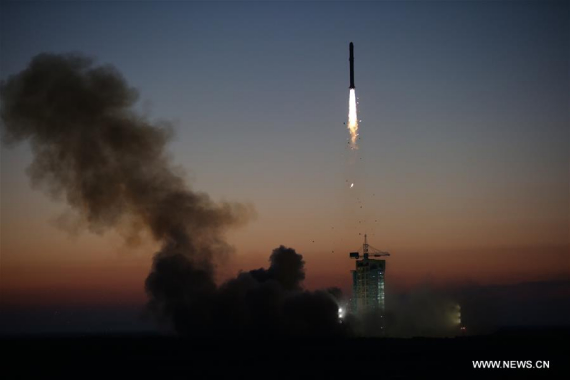
A Long March 2-D rocket carrying the Dark Matter Particle Explorer Satellite blasts off at the Jiuquan Satellite Launch Center in Jiuquan, northwest China's Gansu Province, Dec. 17, 2015. The satellite, nicknamed "Wukong" after the Monkey King with penetrating eyes in the Chinese classical fiction "Pilgrimage to the West", is the country's first space telescope in a fresh search for smoking-gun signals of dark matter, invisible material that scientists say makes up most of the universe's mass. (Photo: Xinhua/Jin Liwang)
China on Thursday sent into space the country's first space telescope in a fresh search for smoking-gun signals of dark matter, invisible material that scientists say makes up most of the universe's mass.
The Dark Matter Particle Explorer (DAMPE) Satellite, nicknamed "Wukong" after the Monkey King with penetrating eyes in the Chinese classical fiction Journey to the West, was blasted off Thursday morning on a Long March 2-D rocket from the Jiuquan Satellite Launch Center in northwest China's Gansu Province.
It will enter a sun-synchronous orbit at a height of 500 kilometers to observe the direction, energy and electric charge of high-energy particles in space.
From there, scientists hope the 1.9-tonne desk-sized satellite could help lift the "invisible cloak" on the dark matter and shine more light on the hypothetical mass.
Dark matter, which does not emit or reflect enough electromagnetic radiation to be observed directly, is one of the huge mysteries of modern science.
Theorized by scientists who could not understand missing mass and strangely bent light in faraway galaxies, dark matter has become widely accepted in the physics community even though its existence has never been concretely proven.
Scientists now believe only around five percent of the total mass-energy of the known universe are made up of ordinary matter, whereas dark matter and dark energy make up the rest.
Knowing more about dark matter could hence give humanity a clearer idea about the past as well as future of galaxies and the universe, and will be revolutionary for the world of physics and space science.
With the new DAMPE satellite, scientists will look for evidences of dark matter annihilation or decay.
Wukong will scan the space in all directions in the first two years and focus on sections where dark matter are most likely to be observed afterwards.
More than 100 scientists will study the data sent back by Wukong. Initial findings are expected to be published in the second half of 2016.


















































